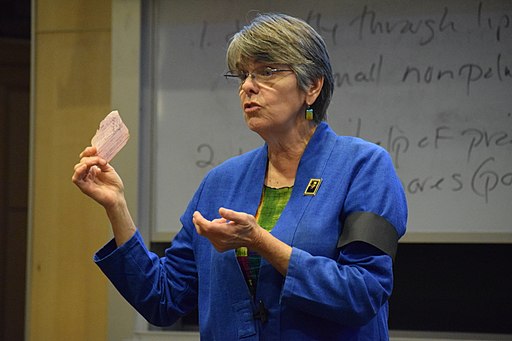Chandler v. McMinnville School District, 978 F.2d 524 (9th Cir. 1992), an oft-cited federal appeals court decision, highlights the contours of the Supreme Court’s major trilogy of student free expression cases: Tinker v. Des Moines Independent Community School District (1969), Bethel School District No. 403 v. Fraser (1986), and Hazelwood School District v. Kuhlmeier (1988).
The case began in February 1990, when public school teachers in McMinnville, Oregon, began a lawful strike.
Students prevented from wearing buttons to support teacher strike
McMinnville High School students David Chandler and Ethan Depweg, whose fathers were striking teachers, wore various “scab” buttons, criticizing the use of replacement teachers and expressing support for the strikers. For example, some of the buttons read “I’m not listening scab.”
When school officials prevented the two students from wearing the buttons, the students filed a federal lawsuit, claiming a violation of their First Amendment rights.
School officials asserted a legal right to force the students to remove the buttons because they were offensive and disruptive within the meaning of the Supreme Court’s decision in Fraser establishing the principle that public school officials can punish students for vulgar and lewd speech (in the case of Fraser, at a school assembly). A federal district court agreed with the school officials and dismissed the lawsuit.
Ninth Circuit said Tinker standard should be applied
On appeal, the Ninth Circuit Court of Appeals reversed and reinstated the students’ lawsuit.
The Ninth Circuit divided student expression cases into three categories based on the trilogy of Supreme Court decisions: “(1) vulgar, lewd, obscene, and plainly offensive speech, (2) school-sponsored speech, and (3) speech that falls into neither of these categories. We conclude … that the standard for reviewing the suppression of vulgar, lewd, obscene, and plainly offensive speech is governed by Fraser, school-sponsored speech by Hazelwood, and all other speech by Tinker.”
The court reasoned that Hazelwood did not govern Chandler’s case because the buttons were not school-sponsored speech. Fraser did not govern the case because the “scab” buttons and the word scab were not vulgar, lewd, or plainly offensive within the meaning of Fraser.
The Ninth Circuit then concluded that the district court should have evaluated the students’ case under Tinker — which involved the political expression of anti-war black armbands — and determined whether the buttons were substantially disruptive of school activities.
Many other lower courts have cited Chandler for its explanation of Supreme Court student speech jurisprudence.
The Ninth Circuit relied on its Chandler precedent to rule in Frederick v. Morse (2006) that the Tinker standard controlled the analysis in whether a student could be punished for displaying a “Bong Hits 4 Jesus” banner across from his school. Although the Supreme Court overruled that decision in Morse v. Frederick (2007), Chandler remains an important lower court, student speech precedent.
David L. Hudson, Jr. is a law professor at Belmont who publishes widely on First Amendment topics. He is the author of a 12-lecture audio course on the First Amendment entitled Freedom of Speech: Understanding the First Amendment (Now You Know Media, 2018). He also is the author of many First Amendment books, including The First Amendment: Freedom of Speech (Thomson Reuters, 2012) and Freedom of Speech: Documents Decoded (ABC-CLIO, 2017). This article was originally published in 2009.

